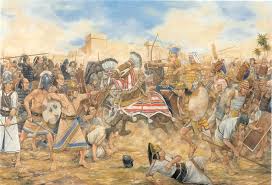The Battle of Megiddo was fought between Egyptian forces under Pharaoh Thutmose III and a large Canaanite army under the King of Kadesh. According to Egyptian records, the date of the battle is the 21st day of the first month of the third season, of Year 23 of the reign of Thutmose III.
It has been claimed that this was April 16, 1457, BC according to the Middle Chronology, although various sources claim the battle took place in 1482 BC or 1479 BC. It is the first battle to have been recorded in relatively reliable detail. Megiddo was also the first battle to record the use of the composite bow and body count of casualties of war.
About battle

All details of the battle came from the hieroglyphic writings on the Hall of Annals in the Temple of Amun-Ra at Karnak, Thebes (now Luxor), by the military scribe Tjaneni. The Battle of Megiddo was an Egyptian victory and resulted in a rout of the Canaanite forces, which fled to safety in the city of Megiddo. Their action resulted in the subsequent lengthy Siege of Megiddo. By re-establishing Egyptian dominance in the Levant, Pharaoh Thutmose III began a reign in which the Egyptian Empire reached its greatest expanse.
Campaign against the Rebels in Canaan
Pharaoh Thutmose III ascended the following the death of female Pharaoh Hatshepsut. He began his reign by curbing a revolt of local rulers near Qadesh (or Kadesh) in the vicinity of modern-day Syria and reinforcing the long standing Egyptian presence in the Levant.
When the Egyptian provinces in the land of the Amurru along the border attempted to change their vassalage, the Canaanites along the Mitanni allied with the Amurru. The driving and main force behind this revolt were the King of Kadesh. The powerful fortress of Kadesh offered protection to him and the city.
The King of Megiddo, with an equally strong fortress, joined the alliance. The importance of Megiddo was its geographical location along the southwestern edge of the Jezreel Valley just beyond the Mount Carmel ridge and the Mediterranean. From this location, Megiddo controlled the Via Maris, the main trade route between Egypt and Mesopotamia.
In the accounts by Tjenani, Thutmose III gathered an army of chariots and infantry that numbered between ten and twenty thousand men. As the Egyptians mustered their forces the King of Kadesh gathered many tribal chieftains from Syria, Aram and Canaan around him entered Megiddo and set his forces at the waters of Taanach.
He expected that his enemy would come by way of Dothaim – Taanach, the main route from the Mediterranean lowlands into the Valley of Kishon, and from Egypt to Mesopotamia. But the Egyptian army assembled at the border fortress Tjaru (called Sile in Greek) and arrived ten days later at the friendly city of Gaza. After one day’s rest, it left for the city of Yehem, which was reached after 11 days. Here, Thutmose sent out scouts.
To continue north, they had to pass the Mount Carmel ridge. Behind it lay the city and fortress of Megiddo, where the revolting forces had gathered. There were three possible routes from Yehem to Megiddo. Both the northern route, via Zefti, and the southern route, by way of Taanach, gave safe and easy access to the Jezreel Valley. The middle route, via Aruna (modern Wadi Ara), was more direct but risky; it followed a narrow ravine, and the troops could only travel single-file.